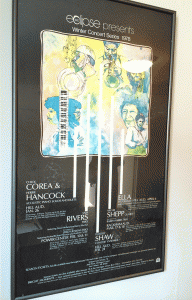Join Us for Our Wide-Ranging Jazz Series
We invite you to join us next season for our 2022/23 Jazz Series — to live the moment and be reminded once again just how special it is to experience incredible live performances together.
We look forward to sharing performances by jazz masters at the forefront of the genre, including Wynton Marsalis, Aaron Diehl, Maria Schneider, and Cecile McLorin Salvant.
Packages start at just $190 for all five performances and as a subscriber, your concert-going experience will be made easy with perks like:
- Access to the best seats at the best prices, before individual tickets go on sale to the general public
- Risk-free ticket returns, refunds, and exchanges
- Installment billing and payroll deduction options
- Free parking when you buy at least six events
- Great discounts on all UMS events all year long!
Listen to our Jazz Series Playlist on Apple Music or Spotify:
Wynton Marsalis’s All Rise
Friday, October 14 // 8 pm
Hill Auditorium
Wynton Marsalis’s All Rise combines a symphony orchestra, a jazz orchestra, and a chorus in a 12-movement arc built on the structure of the Blues, moving from uplifting and energetic to dark and distressing, and finally to Marsalis’s vision of the “togetherness and ascendance” of humanity.
Residency Sponsors: Elaine and Peter Schwetizer
Supporting Sponsor: Anthony Reffells and Jay and Christine Zelenock and the Zelenock Family
Jazz at Lincoln Center Orchestra with Wynton Marsalis
Sunday, October 16 // 4 pm
Hill Auditorium
Since 1988, Wynton Marsalis has led the 15-piece Jazz at Lincoln Center Orchestra, which simultaneously honors the rich heritage of Duke Ellington and Louis Armstrong while presenting a stunning variety of new works. Following Friday’s performance of All Rise, the group returns in its big band format for an afternoon of jazz.
Residency Sponsors: Elaine and Peter Schwetizer
Supporting Sponsor: Anthony Reffells and Jay and Christine Zelenock and the Zelenock Family
Aaron Diehl Trio: Mirror
Friday, January 27 // 8 pm
Rackham Auditorium
This performance showcases Diehl’s fluency in both classical repertoire and dynamic jazz improvisation. He and his trio explore the connections between J.S. Bach’s counterpoint and the vocabulary of bebop, interspersing solo sections from The Well-Tempered Clavier with music by jazz composers such as Miles Davis, Chick Corea, Bud Powell, Dizzy Gillespie, and Diehl himself.
Permanently Endowed Support: Helmut F. and Candis J. Stern Endowment Fund
Maria Schneider Orchestra
Saturday, March 11 // 8 pm
Hill Auditorium
“Maria Schneider is a national treasure,” proclaims National Public Radio. The 2019 NEA Jazz Master, 2021 Pulitzer Prize finalist (for her 2020 album Data Lords), and seven-time Grammy winner brings her 18-member collective to Hill Auditorium for their long-awaited UMS debut.
Cécile McLorin Salvant
Friday, April 14 // 8 pm
Hill Auditorium
A UMS favorite since her 2017 debut, Cécile McLorin Salvant continues to defy expectations with her genre-obliterating virtuosity. The singer, composer, and visual artist has a passion for storytelling and finding the connections between blues, folk traditions from around the world, theater, jazz, and Baroque music.
Supporting Sponsors: Peter Toogood and Hanna Song
Ann Arbor History: Chick Corea and Herbie Hancock in Hill Auditorium
We are devastated that Chick Corea, one of the most prolific jazz greats of our time, passed away on Tuesday, February 9, 2021. UMS first presented Chick in 1994 at the Power Center, and most recently in 2019 as part of his ‘Trilogy’ tour with Christian McBride and Brian Blade. In addition to his seven UMS appearances spanning nearly three decades, Chick’s remarkable discography of nearly 90 albums includes a special connection to Ann Arbor and Hill Auditorium.

Hill Auditorium stage: April 16, 2015
Photo by Mark Jacobson, UMS
On Thursday, April 16, 2015, UMS presented An Evening with Chick Corea and Herbie Hancock at Hill Auditorium. Two “nested” grand pianos with their lids removed adorned the stage at Hill Auditorium as a sold-out audience eagerly anticipated the forthcoming music. Some audience members in attendance may have remembered that this was not the first time that Chick and Herbie appeared alone together on the Hill stage; one would have to dive back to a winter night in February 1978 that ultimately resulted in side four of the now-classic album, An Evening with Herbie Hancock & Chick Corea: In Concert.
Please enjoy revisiting this musical gem of Ann Arbor history:
In 1978, jazz legends Chick Corea and Herbie Hancock were brought to Ann Arbor by Eclipse Jazz, a University of Michigan student group that existed from 1975 to 1987. Eclipse brought world-class jazz musicians to Ann Arbor for concerts, lectures, and workshops, and presented such greats as Ella Fitzgerald, Dizzy Gillespie, Miles Davis, Charles Mingus, Dexter Gordon, Sun Ra, Oscar Peterson, Mary Lou Williams, Sonny Stitt and Rahsaan Roland Kirk.
We asked Lee Berry, former director of Eclipse Jazz and current Chief Development Officer at the Michigan Theater, to tell us all about the epic concert.
Hancock and Corea’s first show together at Hill Auditorium was scheduled for January 26, 1978, a date that might ring some bells for those who were university students during this time, because it was also known as the Great Blizzard of 1978. The University shut down due to snow that day.
Says Berry, “I think we learned that school was being cancelled, and then they called and said that [Herbie and Chick] couldn’t get out of New York.” The only reschedule date that worked for the musicians, Eclipse, and Hill Auditorium was February 26, 1978. The sold-out performance was to occur that day during the day time. Still, most of the 4177 ticket holders showed up, and, as Berry puts it, “it was a beautiful, beautiful show.”
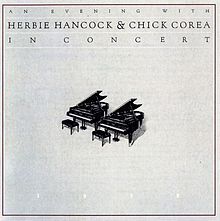 The encore of that Hill Auditorium performance is side four of An Evening with Herbie Hancock & Chick Corea: In Concert, an album that Berry describes as a departure from the electric keyboard and fusion style of jazz that Corea and Hancock were known for before that album, and as a return to the acoustic piano and older, more collaborative style of playing that is the kind of jazz that has survived and is still thriving today. The recording, featuring two jazz greats changing the course of jazz’s future, was a moment in history. As Berry remembers, “Not too long after is when Wynton [Marsalis] came out, maybe ’81, and it was like old-school was back. This was kind of like a link between those two periods.”
The encore of that Hill Auditorium performance is side four of An Evening with Herbie Hancock & Chick Corea: In Concert, an album that Berry describes as a departure from the electric keyboard and fusion style of jazz that Corea and Hancock were known for before that album, and as a return to the acoustic piano and older, more collaborative style of playing that is the kind of jazz that has survived and is still thriving today. The recording, featuring two jazz greats changing the course of jazz’s future, was a moment in history. As Berry remembers, “Not too long after is when Wynton [Marsalis] came out, maybe ’81, and it was like old-school was back. This was kind of like a link between those two periods.”
Stream the full album, including “Maiden Voyage” and “La Fiesta” recorded in Hill Auditorium, on Apple Music or Spotify.
For further reading:
Herbie Hancock on Chick Corea: ‘He Always Wanted to Share Whatever He Had’ (Rolling Stone)
Updated 2/19/2021
Wynton Marsalis’s Musical Gifts
Wynton Marsalis and the Jazz at Lincoln Center Orchestra brought incredible musical gifts to Ann Arbor to kick off the Holiday season.
From an inspiring School Day Performance with 2,400 young people to a full house at Hill Auditorium, the legendary ensemble spread joy and good cheer with the debut of their “Big Band Holidays” national tour. Here are seven of our favorite moments:
1. Welcome Dinner
U-M Director of Athletics Warde Manuel and UMS President Matthew VanBesien welcomed Wynton Marsalis and the Jazz at Lincoln Center Orchestra members to a private dinner to kick off their week of rehearsals.

Warde Manuel, Wynton Marsalis, and Matthew VanBesien
Guests were treated to a performance with jazz students from Ann Arbor’s Community High School, who also spent time with Wynton and the band members throughout dinner.
2. A surprise guest!
U-M Jazz Studies student Ben Green got quite the surprise — a chance to play lead trumpet next to Wynton Marsalis in three rehearsals! On lightning fast notice, Ben graciously stepped in for a weather-stranded member of the Jazz at Lincoln Center Orchestra.
View this post on Instagram
3. School Day Performance
More than 2,400 K-12 students from 41 area schools, including 318 students from Detroit, brought anticipation and joy to the School Day Performance at Hill Auditorium.

4. Workshops in local schools
Many students participated in free pre-show workshops at their schools, where professional teaching artists introduced jazz and what the students could expect to experience at Hill.
5. Q & A with Students
Detroit High School students had the amazing opportunity to visit with JLCO’s bass player Carlos Henriquez, who shared his own experience of growing up in the South Bronx and how an afternoon school program and his commitment to music helped him become a professional musician.

6. Backstage with Wynton
Tappan Middle School students had a quick backstage “meet & greet” with the jazz great, who enthusiastically supports the ways UMS engages young people at a critical point in their lives.

7. Big Band Holidays!
Vocalists Vuyo Sotashe and Veronica Swift added to the holiday magic and big band sound of Wynton Marsalis and the JLCO.
View this post on Instagram
—
A huge thank you to Wynton and the Jazz at Lincoln Center Orchestra for a week of unforgettable experiences for audiences of all ages! Be sure to follow @WyntonMarsalis and @JazzDotOrg on Instagram as they tour into the new year.
A Love Supreme Playlist
This post is a part of a series of playlists curated by UMS staff, artists, and community. Check out more music here.
We’ve been working with WCBN, the University of Michigan student-run community free-form radio station, to feature playlists from their DJs on UMS Lobby. WCBN broadcasts at 200 watts to the University and its surrounding communities from the Basement of the Student Activities Building in downtown tree-town. Check out their website or Facebook page to learn more!
Veteran DJ Richard Wallace, virtual musical encyclopedia arwulf arwulf and recent UM Music School grad Kirsten Carey have created this playlist to celebrate John Coltrane’s A Love Supreme which turns 50 this year. The Campbell Brothers perform A Love Supreme on Friday, February 20, 2015, 8:00 pm at Michigan Theater.
Selections 1-10 consist of albums released in 1964 and 1965 to give a context to the shifting jazz culture which both gave birth to and was advanced by A Love Supreme. The mid sixties were a watershed point in jazz history: among a certain faction of the jazz community, freer improvisational structures were gaining ground as heads were becoming simpler, more melodic, and harmonically loose. These open structures allowed bebop vocabulary to be completely decontextualized and performers to reduce their improvisations into pure emotional sound. Never before had jazz incorporated so much sonic freedom – and, of course, a visionary like Coltrane saw the opportunities this shift heralded. – Kirsten Carey
John Coltrane’s musicality and spirituality underwent profound transformation in 1957. If at that time Thelonious Monk ushered Trane through a creative threshold, the saxophonist’s progress was accelerated through complete abstinence from alcohol and narcotics. Anchored by a marrows-deep personal relationship with religion – the enzyme of survival for generations of African Americans living in a hostile and indifferent environment – Coltrane’s astonishing evolution brought him into solidarity and alignment with artists who actively pursued a collective course that transcended conventionally accepted notions or standards of entertainment. The list that we provide here represents a glimpse of what is condoned and encouraged among students and volunteers in line with WCBN‘s enduring artistic and educational mission. – arwulf arwulf
Artist Interview: Petra Haden, violinist and vocalist

Photo: Petra Haden. Photo by Steven Perilloux.
Violinist and vocalist Petra Haden has been a member of groups like The Decemberists and has contributed to recordings by Beck, Foo Fighters, and Weezer, among others. With her sisters, Petra is a member of the group the Haden Triplets and will also be familiar to UMS audiences as the daughter of the legendary jazz bassist Charlie Haden.
She performs as part of guitarist Bill Frisell’s When You Wish Upon a Star group on March 13, 2014 in Ann Arbor. The two have also created recordings together.
Greg Baise is the curator of public programs at the Museum of Contemporary Art Detroit. This summer, Greg spoke with Petra about working with Bill Frisell, growing up in a musical family, and her interest in the nooks and crannies of film scores.
Greg Baise: This particular UMS appearance actually encompasses two evenings and is called the Bill Frisell Americana Celebration. The first evening features Bill Frisell on guitar solo. And the second evening features you as part of When You Wish Upon a Star, a relatively new band. Can you tell me more about the band and the material you’ll be working on for the concert?
Petra Haden: We’ll play from our record, the first record [Bill and I] did together. This record came to be after I played a show in Seattle with a friend of mine, and Bill came to see that show. He was interested in what I was doing, and he called me soon after to ask if we could do a record together. I was really excited to work with him because I’m such a huge fan! We decided to record a collection of our favorite songs, a variety of music from Coldplay to Stevie Wonder to Tom Waits. “When You Wish Upon a Star” was one of the songs we worked on, and our concerts together so far have been a mixture of these songs as well as Gershwin songs.
GB: In another interview you said that Bill gets your brain. What do you mean by that?
PH: It’s something that I can’t exactly put into words. It’s so hard to describe. When we play, it’s like this language that we speak together. It’s almost like he can predict where I’m going to go next. I remember hearing him when I was younger and thinking how beautiful it was, and to finally be recording with him is a dream come true.
When I was recording with Bill for my Petra Goes to the Movies album, one of the engineers told us that we seemed like brother and sister when we worked together. So, it’s also apparent to others that we’re a good match musically.
GB: I’d love to hear about the arrangement process. Do you and Bill work together to come up with arrangements for these songs?
PH: When we started working on our first record, Bill played and I sang the melody. When we were done with the basic tracks, I added violin. I just came up with stuff on the spot. I played what I heard in my head. I came up with the string ideas for songs that I’d heard, like the songs by Stevie Wonder, and also for songs like Elliott Smith’s “Satellite,” which I’d never heard before, but Bill had played for me. That’s another way he gets my brain. He told me that I had to hear this Elliott Smith song, and that became my new favorite song. He gets my taste is in music.
GB: Listening to you as you create harmonies on the record is pretty astounding. Does it come from something that you studied, or maybe from your upbringing in a musical family?
PH: I started singing with my sisters when we were really young, probably six or seven. We used to visit my dad’s family in Springfield, Missouri. They had a radio show called “The Haden Family,” and we would sit in the living room and have fun, eat, and sing together. That’s one of the first experiences I had with singing harmonies. I remember knowing at a very young age that I loved singing harmonies, and as I grew up with my sisters, we sang just for fun.
I wasn’t really active in music in high school. But later, after I graduated, I joined a band called That Dog with my sister Rachel and another high school friend. I was involved with that band for five years. I ended up going to music school at Cal Arts (California Institute for the Arts), but just for a year, so I never really had formal music training. That’s why I tend to do everything from my head, which can be hard.
GB: Has your record with your sisters, The Haden Triplets, been in the making since your childhood?
PH: Ten years ago or so we worked with a friend who wrote a few songs for us, but we weren’t recording an album at that time—it was just for fun. Any show we played, we sang these songs, and we added [the American folk group] Carter Family songs that we’d known since we were kids. But we were all busy and didn’t pursue an album, though people often asked us when we might record.
Later, we were asked to perform at a tribute show for soul and jazz poet Gil Scott-Heron, and when percussionist Joachim Cooder found out that we were a part of it, he wanted to play drums with us. He mentioned that his dad [the guitarist Ry Cooder] was interested too, so Ry played guitar with us for that show. He’s the one who called me after to say that he was interested in producing a Haden Triplets record. I was very excited because I’m a big Ry Cooder fan. We recorded it at my sister Tanya’s house before she moved in. It’s an old, big house with tall ceilings, and it was empty, so it was a great place to record.
GB: Your most recent record is Petra Goes to the Movies. I’d like to hear about your relationship to film scores in particular.
PH: I’ve always thought about doing an A Capella “Movies” album. Since I was a kid I was obsessed with all the Superman movies. I had the vinyl for the soundtracks, and I listened to them a lot and sang the string parts in my head. That was my favorite thing about going to the movies, listening to the music. Music is what tells me the story whenever I watch a movie.
GB: In the album, you’re looking at the nooks and crannies of a soundtrack that people don’t normally look at.
PH: That’s interesting that you bring that up. Often in movies, the music that I wish was on the soundtrack doesn’t ends up on it. Like in Big Night for instance, there’s a scene that just touched me, during which the owner of the restaurant with which the brothers compete plays piano. I don’t think that’s even on the soundtrack. My friend (who engineered the album) got the video and recorded it for me so that I could hear it.
Bill plays on that album too, so it’s not entirely A Capella. He thought of the theme from Tootsie, one of my favorite movies, and that’s another example of the way that he just gets my brain.
GB: Are you planning on recording another album with Bill and the When You Wish Upon a Star group that will play in Ann Arbor, or is that to be determined?
PH: That’s to be determined. I want to record with Bill for sure, but for my next record, I’m focusing on original songs. I work really well with collaborators, so I want to find the perfect writing partner.
GB: Earlier, we talked about the way you’ve admired Bill’s work for a long time. You said that to work with him is almost like a dream project. Do you have a list of other dream projects, whether that’s material or collaboration?
PH: Lately, I’ve been listening to an album by Mark Isham called Vapor Drawings. I don’t know how to get in touch with him, but he’s someone I would want to work with. I would definitely love to work with [the composer] Steve Reich, to be one of his singers. His music is another way I learned to harmonize. I love that pulsating singing so much. My other favorite guitarist is Pat Metheny. I did have the chance to work with him when I worked on my dad’s record Rambling Boy. On that record, I sing on a song that Pat plays on, which was a dream come true.
GB: Thanks for taking the time to talk! I was really excited when I saw that you would be playing in with Bill Frisell.
UMS Playlist: A Touch of Minimalism
This post is a part of a series of playlists curated by artists, UMS Staff, and community. Check out more music here.
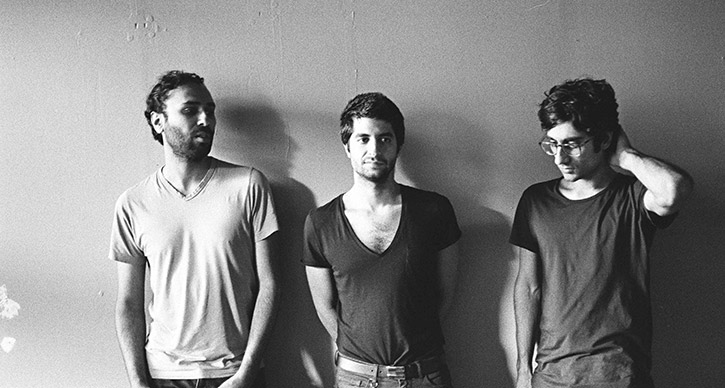
Dawn of Midi perform at Trinosophes in Detroit on January 31, 2015. Photo by Falkwyn de Goyeneche.
Minimalism can be extraordinarily beautiful. I’ve always been a believer of “less is more.” In the right hands, repetition, simplicity, and homogeneous textures of sound can envelop the listener in deeply meaningful and even spiritual ways.
In the playlist below, I’ve attempted to offer a sampling of minimalist techniques in a cross-section of genre and style, from pioneering tape experiments by Steve Reich (“It’s Gonna Rain,” ca. 1965) to minimalist 1990s electronica from the UK’s Richard D. James (aka Aphex Twin) and the Manchester duo Autechre (selected from their seminal 1995 LP Tri Repetae) to Dawn of Midi, a group with a mesmerizing, “electro-acoustic” sound that will perform at Trinosophes on January 31, 2015.
I have also included some surprises: Jason Moran and The Bandwagon’s cover of American-born innovator Conlon Nancarrow (who composed “Study No. 6” for player piano) and downtown New York experimental post-disco songwriter, cellist, and composer Arthur Russell (who died in 1992 at the age of 40 in relative obscurity).
This playlist represents merely a snapshot of some of my favorite minimalist moments. Hopefully it will encourage and inspire a deeper personal journey of discovery.
Please note: These fascinating (and intricate) soundscapes are best experienced on headphones.
What did you think about this playlist? Share your thoughts or song suggestions in the comments below.
Listening Guide in Samples: Bob James
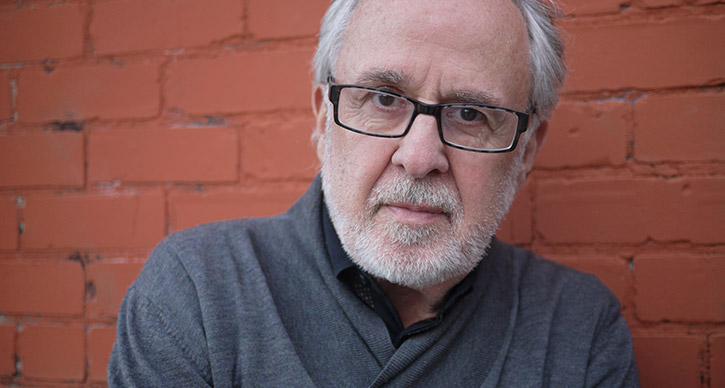
Jazz keyboardist and composer Bob James is also one of the most sampled musicians in the history of hip-hop. He’ll perform in Ann Arbor on November 15, 2014. Photo courtesy of the artist.
Hip-hop appropriated the soul and rhythms of many genres of music and cultures, and hip-hop is contagious. It’s a force that blasted its way out of the inner city into bedrooms and basements everywhere.
Hip-hop is rooted in making something out of nothing, using the few tools at the musicians’ disposal to create art that paints a picture of a part of society largely ignored. Before hip-hop’s inception, jazz, blues, soul music, and rock-n-roll were the prior generations’ outlets for creating a rich counter-culture that would influence the communities of the future. Hip-hop was an explosive melting pot of all of these cultures, and so it wasn’t shocking that many of musicians who had begun to experience success in earlier decades enjoyed a new life through sampling in hip-hop. One such example is jazz pianist Bob James.
From One by Bob James:
In the 70s, James was arranging and producing with many fellow jazz artists, including on saxophonist Grover Washington Jr.’s classic albums, while also putting out his own solo albums like One or Two. These albums and his other music would become the foundation of many hip-hop staples of the 80s and 90s. The worlds Bob James would create during this time, while working with musicians such as saxophonist Dave Sanborn, singer Hubert Laws, and drummer Idris Muhammad, to name a few, were filled with a massive soul that mixed dreams of fantastical lands with the struggles of reality. The culture of hip-hop would reinvent that feeling in the following generations.
“Angela” by Bob James:
Bob James, who is an alumnus University of Michigan, would go on to success in the jazz world, but his music really entered American living rooms everywhere when he penned “Angela,” the theme music for the popular TV show Taxi that aired from 1978 to 1983 and spawned a slew of well-known actors and comedians. Later on, “Angela” would be sampled by Bay Area hip-hop group Souls Of Mischief for their song “Cab Fare”, which was slated for their 1995 full length album No Man’s Land but was unfortunately axed because they could not get the sample legally cleared (it’s out there now, go look for it!).
The works of Bob James have been sampled many times within hip-hop as well as by R&B and drum-n-bass artists, but there are two specific songs that have been used more than anything else and have lead to some well-known hip-hop records.
“Nautilus” by Bob James, sampled:
From the Bob James’ 1974 album One, the closing track titled “Nautilus” has given us great hip-hop songs over the years. As we enter the first few seconds of “Nautilus,” we hear the haunting sounds would be sampled by the legendary producer DJ Premier for Jeru The Damaja’s “My Mind Spray” from his 1994 album The Sun Rises In The East. Then, a few seconds later, right as the song really kicks in, is the sample that the Wu Tang Clan’s The RZA used for fellow group-mate Ghostface Killah’s “Daytona 500” from his 1996 solo album Ironman. “Nautilus” has been sampled in dozens of other songs including by Eric B. & Rakim (“Let the Rhythm Hit ‘Em”) and Soul II Soul (“Jazzie’s Groove”), but it’s the segment about two-thirds into the composition, during another ghostly breakdown, that Run D.M.C. would pick up and turn into the main infectious sample for their renowned record “Beats to the Rhyme.”
“Take Me to the Mardi Gras” by Bob James, sampled:
While the sampling of “Nautilus” spawned many hip-hop tracks, James’s 1975 album Two and the song “Take Me to the Mardi Gras” resulted in some of the most legendary tracks. The bells and drum breaks from “Mardi Gras” would be most famously sampled by hip-hop legends like Run D.M.C. (“Peter Piper”), LL Cool J (“Rock The Bells”), and the Beastie Boys (“Hold It Now, Hit It”). “Take Me to the Mardi Gras” isn’t just the foundation for these celebrated songs, it’s also the backdrop for the sound of late 80s hip-hop culture. Those bells and drums from “Mardi Gras” create the vision of inner city kids break-dancing on the sidewalks, spitting rhymes on the corner, or tagging graffiti on a wall downtown.
Bob James has continued to produce and arrange music as a highly successful solo jazz artist and along with his legendary band Four Play, but his work from the 1970s as a producer, arranger, and as solo artist has left a lasting effect on in the hip-hop world, an effect that will continue for generations of emcees and producers to come.
Interested in learning more? Check out Kelly Frazier’s listening guide to pianist Ahmad Jahmal, who’s also been sampled into the hearts of hip-hop.
Behind the Scenes with Gregory Porter
This post is a part of a series of playlists curated by artists, UMS Staff, and community. Check out more music here.
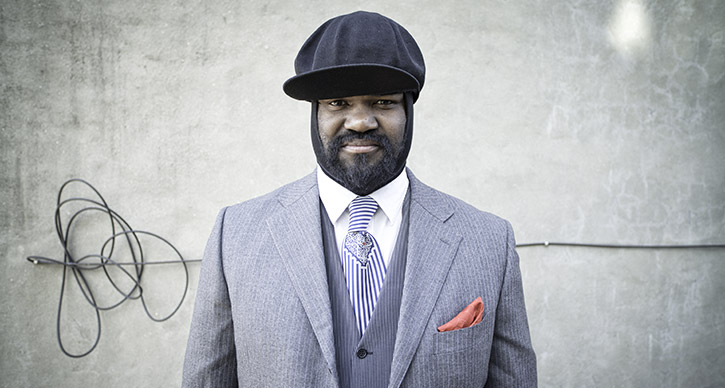
Photo: Gregory Porter. Photo by Shawn Peters.
NPR Music has hailed Gregory Porter as “the next great male jazz singer.” His album Liquid Spirit, which has gospel, blues, and R&B influences, was recently awarded the 2014 Grammy Award for “Best Vocal Jazz Album.” We can’t be more excited to present Gregory Porter at the Michigan Theater in Ann Arbor on October 15, 2014.
We asked Gregory to share a few of his favorite tunes with us, and to tell us about why these songs inspire him. Check out his selections and listen along below.
Nature Boy – Nat King Cole
Gregory Porter: Because he’s a favorite of mine. His lyrical expression, the depth and tone of his voice is extraordinary. He was also a great song-smith, and a great song craftsman and song selector in a way. Because with “Nature Boy,” the entire construction is about that last line, “the greatest thing you’ll ever learn is just to love and be loved in return.” That’s something that’s a good thing to walk through life with.
Compared to What – Lester McCann
Gregory Porter: This is a statement of his personality. Although he didn’t write the tune, the way he expresses it is as though you’re reading from his personal journal. It is also a mix of soul, gospel and blues, and in a way, this is the school that I’m coming from. It’s just so so so soulful!
In a Sentimental Mood – Duke Ellington
Gregory Porter: It’s just classic and beautiful. When I hear it, it reminds me of open windows during spring and fresh air blowing through the house. I can’t explain why, that’s just the way it is for me!
What did you think about this playlist? Share your thoughts or song suggestions in the comments below.
Interview: Ford Honors Program featuring JLCO and Wynton Marsalis
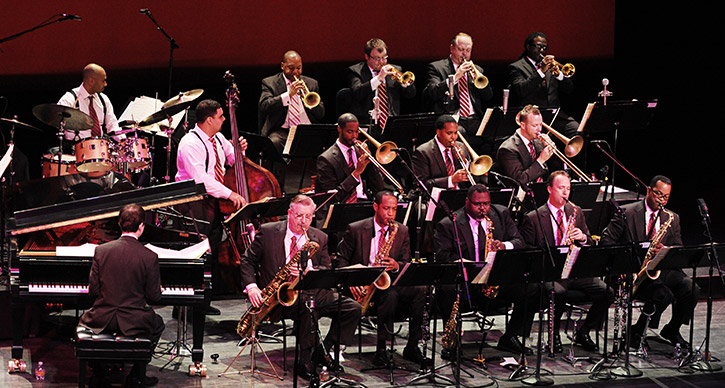
Photo: Jazz at Lincoln Center Orchestra and Wynton Marsalis in concert. They’ll perform in Ann Arbor on March 30, 2014. Photo by Frank Stewart.
Each year, the UMS Advisory Committee (an organization of over 60 volunteers who contribute over 7,500 hours of service to UMS each year) works together with UMS staff on the UMS Ford Honors Program Gala. FHP is our annual benefit that supports UMS’s Education & Community Engagement Program, which provides free or low-cost education and community engagement activities focusing on K-12 students, teachers, teens, university students, families, adults, and cultural communities. Funds raised from the Gala make it possible for UMS to impact nearly 20,000 youth, educators, and community members each season.
This year, we’re excited to honor Wynton Marsalis and the Jazz at Lincoln Center Orchestra, artists who have a long history with UMS, and also a deep commitment to education.
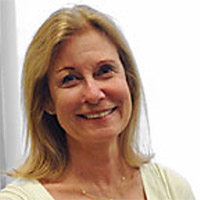 We sat down with Cheryl Cassidy, who’s leading the FHP efforts this season. Cheryl is a resident of Ann Arbor and a professor in the English department at Eastern Michigan University.
We sat down with Cheryl Cassidy, who’s leading the FHP efforts this season. Cheryl is a resident of Ann Arbor and a professor in the English department at Eastern Michigan University.
Caroline Kagan: What are you most excited about in this year’s program?
Cheryl Cassidy: I’m always excited about Ford Honors. We have been going, my late husband and I, and my daughter also, for the past thirteen, fourteen years. For me and for my family it’s always been a really exciting thing to be with people who are interested in the arts and to be a part of that community.
Of course I’m excited this year because Wynton Marsalis is just such a stellar performer. To be part of planning the whole thing is exciting, too. It’s fun, and it’s nice to be a contributor in a way that is very meaningful.
CK: Have you attended Jazz at Lincoln Center Orchestra and Wynton Marsalis performances in the past? If so, what do you like about them?
CC: You know, I thought about this question, and I was trying to think, what is it? I think a part of it is that not only does Wynton Marsalis excel at what he’s doing in his art, but he also has this very uncommon ability to transcend his medium. He goes beyond what’s predictable, in terms of musical boundaries, as does the Jazz at Lincoln Center Orchestra. Along with that there’s this inclusivity that happens, so that the audience and the performers feel a part of the whole experience. That’s both a very fragile and a very unusual thing.
Secondarily, I’m excited because Wynton Marsalis and the Jazz at Lincoln Center Orchestra have such an impact on our community. They’ve created possibilities for educational experiences for students, particularly those students who, under normal circumstances, would not be able to attend a concert like this. Of course the donors for this performance and gala are then supporting the continuation of those educational programs.
CK: Related to that thought, what do you think the Ford Honors Program brings to the community at large?
CC: I think the Ford Honors Gala in general and this particular performance and honoree in particular really reflect our community’s devotion to the arts. It’s not just a singular devotion. I think it’s very multifarious. In other words, it includes universities like the University of Michigan and Eastern Michigan University, the community in Ann Arbor, Ypsilanti, and beyond in the region. Wynton Marsalis and the JLCO really appeal to a great number of people. The gala reflects our commitment and our devotion to these stellar performers and indicates how much we value their creativity and how it enriches our lives.
CK: You also chaired the committee that planned the 2006 Ford Honors Program, which honored jazz pianist and composer Dave Brubeck. What did you learn from that experience, and how have you incorporated those insights as you plan for this Ford Honors Program?
CC: I think the most important thing that I learned and that I experienced was the importance of having a really good team, a team of people who are dedicated and who are highly invested in the event, and we’re very lucky to have a great team working on this year’s FHP.
CK: Now I’m going to ask you a very hard question. Why do you support the arts?
CC: That is a hard question and that involves so much emotion. I think that for me, personally, the arts really enrich my life. And I think that the arts are part of how we are human. We have to incorporate the arts into our lives, because that makes us better people, better community members, better people in the world, because the arts transcend cultures. They are for the world and for everyone.
I buy into all that, but I think also my late husband was just fiercely devoted to UMS. He wanted to go to every concert and I sort of had to say, “We can’t do it all!” He was really a person who treasured the idea that UMS was here in Ann Arbor, as do I. So I’ve been very conscious of that legacy, as has my daughter, and I think that’s part of it as well.
Interested in learning more about this year’s Ford Honors Program? Visit our FHP event page where we’ll keep the most up-to-date information about the gala.
UMS Director of Programming Picks Five Notable UMS Debuts
One of the reasons we’re so excited about our 2015-2016 season is the debut performances. Winter is especially ripe with UMS debuts, including by mezzo-soprano Jamie Barton, pianist Igor Levit, vocalist Tanya Tagaq, among many others.
Debuts are an important part of our 135-year-history. Every artist debut has embedded in it that same kind of hope and optimism, something truly great might come of all this talent which is being revealed to us for the first time. At UMS, every debut also holds the possibility of a life-long relationship between that artist and our community of music lovers.
Here are five notable debuts which grew into a fully formed career and lifetime of memories for UMS audiences:
Violinist Yehudi Menhuhin – UMS debut, 1932
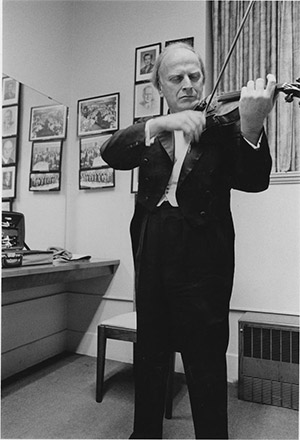 Photo: Yehudi Menuhin readies for the 1974 UMS May Festival (UMS Archives).
Photo: Yehudi Menuhin readies for the 1974 UMS May Festival (UMS Archives).
Menuhin made his concert debut at UMS when he was age sixteen. He went on to give eighteen UMS concerts over the course of his career most often as violin soloist but also as a conductor later in his life. His last appearance was in February of 1987 fifty-five years after his debut.
Pianist Artur Rubinstein – UMS debut, 1938
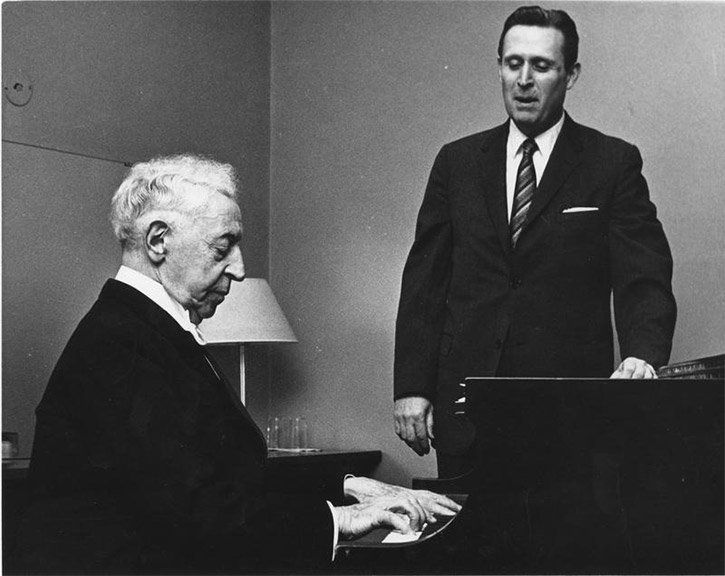
Photo: Pianist Arthur Rubinstein and former UMS president Gail Rector (UMS Archives).
The great Polish pianist Artur Rubinstein didn’t make his UMS debut until he was 51. He played Tchaikovsky’s First Piano Concerto with the Philadelphia Orchestra at May Festival. Even though he was middle aged when he first come to Ann Arbor, he still managed to give fifteen concerts for UMS over the course of his career, the last one, a benefit recital in January 1971.
Soprano Leontyne Price – UMS debut, 1957
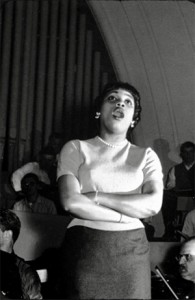
Photo: Leontyne Price sings her first career Aida in concert version with the Philadelphia Orchestra at the May Festival (UMS Archives).
Price had a double debut when she first come to UMS for the May Festival in 1957. Not only was it her first performance in Ann Arbor, but it was also her first public performance of the title role of Aida, a character she went on to own and dominate in every important opera house in the world. By the time she gave her last UMS recital in 1991, she had visited Ann Arbor to perform eight times.
Mezzo-soprano Cecilia Bartoli – UMS debut, 1993
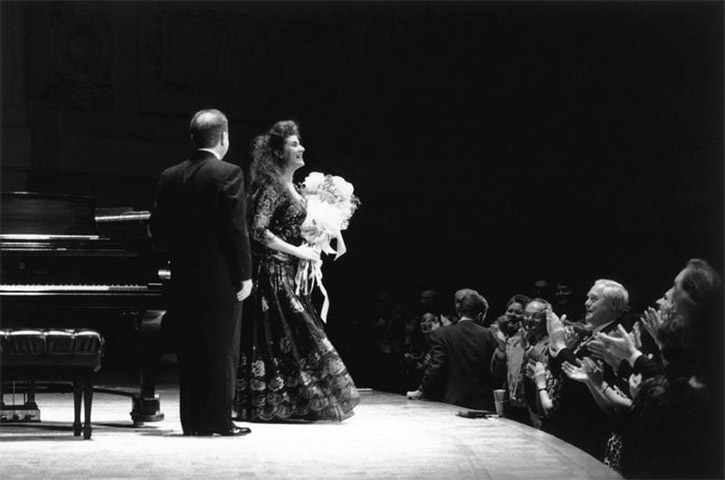
Photo: Mezzo-soprano Cecilia Bartoli and pianist Martin Katz receive a standing ovation at her UMS debut, April 10, 1993 (UMS Archives).
Bartoli gave her debut recital performance in Hill Auditorium when she was relatively unknown. She was partnered by Ann Arbor’s very-own pianist Martin Katz. Her most recent appearance was in February of 2004 with the Orchestra of the Age of Enlightenment in a program devoted to the music of Antonio Salieri.
Trumpeter Wynton Marsalis – UMS debut, 1996
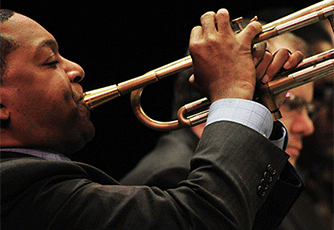
Photo: Trumpet Wynton Marsalis will receive the UMS Distinguished Artist Award as part of this season’s Ford Honors Program on March 30, 2014 (Photo courtesy of the artist).
The great jazz (and classical) trumpet virtuoso Wynton Marsalis gave his first UMS concert with his Lincoln Center Jazz Orchestra Octet in 1996. Since that time he has become an almost annual fixture on the UMS season while, simultaneously, becoming a singular international voice for the centrality of jazz to American culture.
Do you have your own notable debuts or early performance favorites in UMS history? Share them in the comments below.
Buena Vista Social Club is a Party Foul
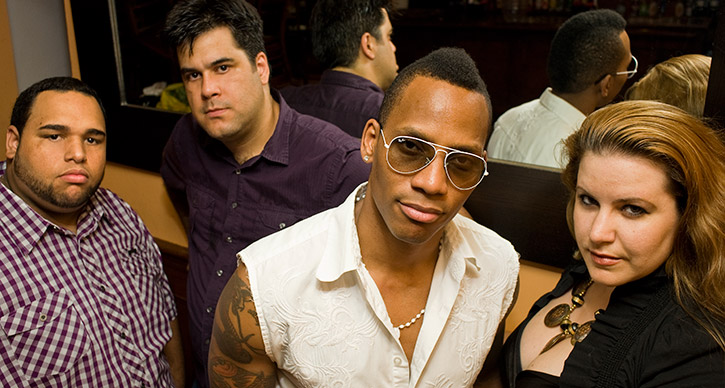
Photo: Pedrito Martinez Group. The group performs with Alfredo Rodríguez Trio on March 14, 2014 in Ann Arbor. Photo by Petra Richterova.
Has this ever happened to you? You find yourself in a conversation with someone who knows a lot about music (and probably craft brewed beer, artisanal fermented foods, and expensive jeans). When the topic shifts to Cuban music you make the mistake of saying something like, “Oh I love Cuban music, I listen to Buena Vista Social Club all the time.” A smirk quickly appears on the face of your friend. All of the air goes out of the room. You know you have said something terribly wrong, but you are not sure exactly what.
If this has ever happened to you (or even if it hasn’t), you need to get tickets to come see Alfredo Rodríguez and Pedrito Martínez, two talented young musicians from Cuba who are reworking the Cuban sounds they grew up with.
“The Special Period”
First a disclaimer: I love Buena Vista Social Club. I do not care who smirks at me for it. But here is a little context. Buena Vista Social Club appeared in 1997 during what Cubans call “The Special Period.” Cuba’s socialist economy entered a severe crisis after the fall of the Soviet Union, as trade and assistance from Communist Europe suddenly vanished. Meanwhile the United States tightened its trade embargo. In response, the Cuban government shifted its economic strategy towards the development of tourism and the marketing of Cuban culture to international audiences. At the same time, the Clinton administration loosened restrictions on travel by Cuban artists to the United States. Buena Vista Social Club – a phenomenon which includes an album, a film, and many international tours – was the most commercially successful cultural enterprise of this new landscape. And it is brilliant. But the vision of Cuba that Buena Vista Social Club sold was one where time had stood still: a world of crumbling Art Deco buildings, well maintained vintage automobiles, and picturesque elderly black performers playing exactly the same music that they had played in the decades before the revolution.
So the knock on Buena Vista Social Club is that it reintroduced international audiences to a Cuba that no longer existed. This was our loss, because the music that had evolved in Cuba in the 1970s and 1980s, and was still evolving in Cuba in the 1990s and beyond, was pretty special. This is where Alfredo Rodríguez and Pedrito Martínez come in. They came of age in Cuba in the Special Period, when “Chan Chan” played in every bar in Madrid and Paris, but that sort of music was only really heard in hotels catering to tourists in Cuba. Their music gives a glimpse of what was happening in Cuba as the elderly musicians of Buena Vista Social Club conquered the world.
Chan Chan:
Music: A hallmark of Cuban socialism
One of the amazing things about music in Havana in these years was the extent of conservatory training; expanded access to music education was a hallmark of the cultural policy of Cuban socialism. So it was not uncommon for popular musicians in Cuba in these years to have advanced classical training. Born in 1985, Alfredo Rodríguez, the son of well-known popular musician and television personality, grew up in this system. He moved back and forth between the classical training of the conservatory and the popular music he played with his father. Eventually he found his niche in the world of jazz. Cuban musicians from had been experimenting with jazz since the 1970s. By the 1990s, after the much-publicized visit of Dizzy Gillespie to Cuba, the top players in the Cuban jazz world became part of the international circuit. Some defected, but others simply enjoyed the new freedom to tour outside Cuba that came with the new economic strategies of the regime. Rodriguez was playing in Montreaux in 2006 when he met Quincy Jones. Then he was playing with his father’s band in Mexico when he decided to cross the border into the US to work with Quincy.
A second important musical trend in Cuba after the revolution was shifting official policy towards Afro-Cuban folkloric music, percussive styles like rumba, abakua, and batá (the music played during Santería ceremonies). African slaves and their descendants developed these styles of music in the context of spiritual practice and community life not the music industry. In the 1960s and 1970s, the master percussionists of these traditions became employees of state folklore agencies, performing Afro-Cuban music on stage. In the 1990s, folklore groups and the state began selling this version of Cuban culture abroad too. Afro-Cuban cultural groups like Muñequitos de Matanzas began travelling to the US. Pedrito Martínez grew up in this world, winning international competitions in Afro-Cuban hand drumming and entering the world of professional musicianship on international tours with Muñequitos de Matanzas. He also won international exposure as part of a rumba ensemble that appeared in the film Calle 54 (2000). We cannot link to video of this segment because of copyright, but it is worth watching on Netflix if you can.
Muñequitos de Matanzas during their first US tour in 1992:
Timba is perhaps the most important of all the musical innovations in Cuba during the Special Period. Timba was a dance music popular among the urban, Afro-descended Cubans who found themselves increasingly disenfranchised by the shifting economic strategies of the socialist government. Timba lyrics adopted street slang and discussed taboo subjects including the informal economy of hustling, linked to the growth in tourism. Built of the same materials as salsa, timba followed a distinct path. Most important was a restructuring of the classic Cuban dance music around explicitly Afro-Cuban rhythms and a much more experimental approach to rhythm in general. Batá or rumba variants were as likely to form the central rhythmic arguments as the classic son tumbaos. Timba also built on on the funk-fusion sound of the experimental jazz group Irakere.
NG La Banda Santa Palabra:
Bacalao con Pan:
Timba was the alter-ego of Buena Vista Social Club, young and edgy, informed by Cuban jazz, by Afro-Cuban folklore, and often played by musicians who had been trained in conservatories. The point is not that this music was more authentic, somehow free of the influence of marketing. The interplay of international promotion and local musical scenes helped produce a wide range of musical options in and around Cuba over the past twenty-five years, including a dizzying array of musical talent. The upcoming UMS concert offers a glimpse at this world. Alfredo Rodríguez is a conservatory trained technical virtuoso, with a background in Cuban popular music, who grew up idolizing Kieth Jarrett. He experiments at the boundaries between straight ahead jazz and Cuban jazz.
…y bailaría la negra:
Pedrito Martínez is a percussionist who played with Munequitos de Matanzas when that band was already making regular commercial tours around the world. He explores timba and Cuban funk fusion in a small quartet format, just a keyboard, bass, and bongó player to accompany his congas. Both musicians continue to rethink the music they grew up with in conversation with the wide range of international musicians and styles they embody.
Que palo:
Please do not smirk the next time someone tells you that they love of Buena Vista Social Club. Just smile, and tell them about the concert you just saw by Alfredo Rodríguez. Nod and lend them your copy of Pedrito Martínez’s new record with its amazing cover of of Robert Johnson.
Travelling Riverside Blues:
Artist Interview: Cuban Pianist Alfredo Rodríguez
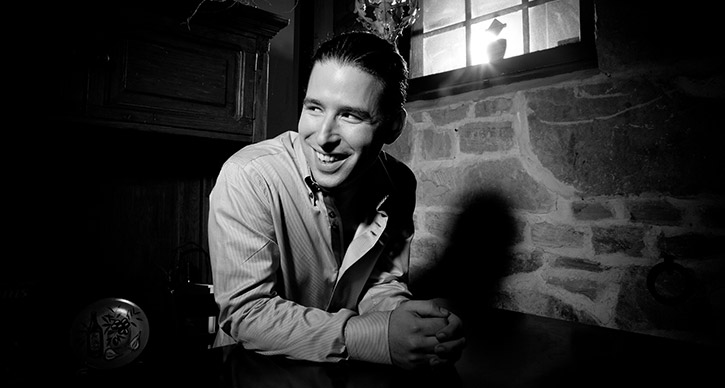
Photo: Alfredo Rodríguez. Photo by Anna Webber.
Alfredo Rodríguez is a Cuban pianist and composer. He was born in Havana, Cuba, in 1985. With a well-known Cuban singer as his father, it is no wonder that he has been surrounded by music his entire life. He started studying at the Manuel Saumell Cuban Conservatory at the age of 7, and has been playing and creating music ever since.
Alfredo spent some time talking with us about his experiences in Cuba and in the United States, his thoughts about a musician’s life, and his upcoming work. He’ll perform in Ann Arbor on March 14, 2014 as part of a unique double-bill with Pedrito Martinez Group.
Annick Odom: We know that you’ve played in Ann Arbor and Detroit before, but we’re really excited to have you playing for the first time with UMS in March. Your work draws on jazz and Cuban music traditions. How do you balance these in your own music?
Alfredo Rodríguez: Well, I started as a part of his [my father’s] band when I was very young, about 13. We used to play popular music, music from the traditions of Cuba and his compositions as well. I combined that kind of performing, that kind of ambiance, with the classical school.
In Cuban music, there is a lot of improvisation, but I didn’t know much about improvisation in classical music at that time. My uncle gave me an album called The Köln Concert by Keith Jarrett [the legendary jazz pianist], and that got me into improvisation.
I was used to Cuban traditional music and classical composers like Johann Sebastian Bach, and also to Latin composers. After that CD though, I found the music of many of the pioneers of the be-bop era, a lot of different musicians, mostly from the United States. I was falling in love with the way those composers and instruments created music.
AO: We presented Keith Jarrett in 2000! What exactly about that recording drew you in so much? What made you so excited about improvisation?
AR: Well, my uncle gave me that CD with an idea in mind, because he was not very involved in piano music. He gave me that CD because he knew that I was very into that world. But I wasn’t expecting anything it. I just put it on. It was a great introduction for me because Keith Jarrett had that touch and that knowledge about classical music, and he shows a lot of those influences in his playing. It was a good introduction for me to improvisation and jazz music, too, of course.
AO: You said that you played a lot with your father while growing up and that you played a lot of popular music in Cuba. How would you say that you’ve individualized yourself from previous generations of musicians from Cuba?
AR: I guess I would say that [the musicians in my generation] are changing every day. We have different experiences every day. [My generation] grew up in a different situation than the generations before us in Cuba. We had different problems, different ways of living, [different] points of view. And of course those differences are the reasons that music changes too.
What I like to do with my music is to just express the present, just express how I am feeling, what I am going through in that exact moment. I guess what I am trying to say is that everybody always has something to say, and it is always different for everybody. And that kind of honesty is what I look for in terms of music, and in terms of living my life.
So it’s very simple for me, I just try to express who I am when I play my music and compose. I try and show my [Cuban] roots and also the transculturation that I have been living since I have been here in the United States.
AO: Do you find yourself playing any differently since you moved to the US or do you play pretty similarly to when you lived in Cuba?
AR: No, I’ve definitely changed. The United States is a different country with different culture, which has been a very positive process for me in terms of learning.
[Cuba] is an island, and due to the country’s political history we have been only around Cubans for more than 50 years. The culture that we have been creating for so many years is very unique and powerful because we are surrounded by Cubans, but at the same time, it’s contradictory because we haven’t had the opportunity to have confrontation and transculturation with different cultures.
I wanted to know different cultures and meet different people with different points of view so that I could incorporate all of that into myself and reflect it in my music.
AO: Let’s talk about your upcoming concert here in Ann Arbor. Who will be coming with you? What will you perform? Can you also talk a little bit about your upcoming album?
AR: Actually I am releasing my next album The Invasion Parade on March 4th, which is going to be very, very close to the concert [in Ann Arbor on March 14]. I am going to be featuring the same trio that I had for my album at the concert. We are featuring different artists, but the main trio that I perform with is Peter Slavov, a Bulgarian bass player, and Henry Cole, a drummer from Puerto Rico.
We are going to be performing the music on this upcoming album as well as music from the past. But to be honest, music is very natural and spontaneous for us, so we just like to play songs that will fit in the moment that we are living.
It’s difficult to say exactly what songs we’ll play or even what the music is going to sound like. I guess what I mean to say is that we have the message that we want to tell people: 70% of my music is improvisation, and the other part is rhythm. So it’s kind of unexpected, and in that way, we learn more from ourselves.
AO: You’re sharing the bill with Pedrito Martinez. Have you ever played with him before?
AR: It’s very funny because Pedrito is part of my album [The Invasion Parade], too. I love his playing! Pedrito is one of the musicians coming out of Cuba that I admire so much because of his incorporation of our culture into his vocals and percussion. And speaking of my album, it also features Esperenza Spalding, and horn players from Cuba and Puerto Rico. But yeah, speaking of Pedrito, we have a really, really close relationship in both in terms of music and friendship.
AO: It seems that you are already thinking a lot about the upcoming months, but where do you see your music going even further into the future?
AR: That is a good question. To be honest, I don’t think too much about the future. What I can share with you is something that I’ve been working on since the past, until today, which is creating music.
I am also currently writing a lot of music for the symphony. The premiere of my first symphonic work will be this year in November, and I will be performing one of my compositions with an orchestra at the Barcelona Jazz Festival. And I’m working on new music for my trio and my upcoming CDs.
I do it [compose music] because I just need it. It’s like water for me. If I am inspired, I write something. I’m just composing music, doing what I like to do. I feel very fortunate about that because I just have the opportunity to live from what I love to do, and I am very grateful for that.
Interested in more? Check out Alfredo’s new album or get tickets to his performance with Pedrito Martinez Group in Ann Arbor on March 14, 2014.
Behind the Scenes with Fred Hersch
This post is a part of a series of playlists curated by artists, UMS Staff, and community. Check out more music here.
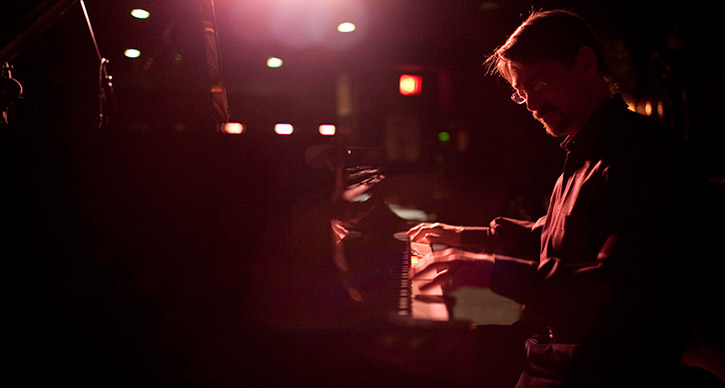
Photo: Fred Hersch performs. Photo by John Rodgers.
The New York Times has praised Fred Hersch as “singular among the trailblazers of their art, a largely unsung innovator of this borderless, individualistic jazz — a jazz for the 21st century.” We’re very excited to host the Fred Hersch Trio in Ann Arbor for two different sets on January 30.
We asked Fred Hersch to recommend some of his favorite jazz pianists.
Fred Hersch: These five pianists are all heavy favorites of mine and not so well-known here in the US. John Taylor has long been Great Britain’s finest jazz pianist – and Gwilym Simcock was his student. “Sweet Dulcinea” is by British trumpeter/composer Kenny Wheeler – with whom I have had the pleasure of playing. I have collaborated with French pianist/composer Benoit Delbecq on a double–trio project “Fun House”: two pianists, two bassists, two drummers and live electronics. He is a master of prepared piano – using mostly wooden sticks of various kinds to elicit otherworldly sounds from the instrument. Bill Carrothers and Kevin Hays are mid-career American pianists whom I follow and always enjoy.
Full list:
Benoit Delbecq: “Strange Loop” from Pursuit
Kevin Hays: “Cheryl” from Live at Smalls
Bill Carrothers: “A Gerkin for Perkin” from A Night at the Village Vanguard
Gwilym Simcock: “These Are The Good Days” from Good Days at Schloss-Emau
John Taylor: Angel of the Presence (CD) Track: “Sweet Dulcinea” from Angel of the Presence
Listen on our Spotify account:
What did you think about this playlist? Share your thoughts or song suggestions in the comments below.
Educator Conversations: Jazz at Lincoln Center Orchestra with Wynton Marsalis
Editor’s note: This post is a part of a series of conversations between educators in the K-12 community. Educators will offer suggestions and answer questions about integrating UMS School Day Performances or the arts into classroom curriculum, as well as share advice on organizing a field trip to UMS. To volunteer to be a Teacher Lobby Moderator e-mail umsyouth@umich.edu. Or, check out other Educator Conversations.
This week’s questions:
- What does Jazz music have in common with the music of Mozart and Haydn?
- How does Jazz music reflect the values of African-American culture from which it came?
- How do you find yourself improvising in your life?
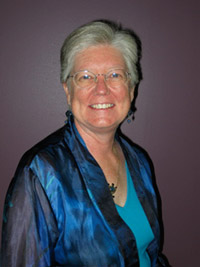 This week’s moderator: Linda Jones. Linda has taught music, math and media in the Ypsilanti Schools from 1999 to 2012. She is currently director of the Ann Arbor Civic Chorus. She has taught jazz history, composition, improvisation and performance as well as acting and creative movement at the elementary level and collaborated with bassist Paul Keller, drummer Sean Dobbins, and pianist Ellen Rowe. She has training as an Orff Music Educator and currently serves as Treasurer to the Greater Detroit Orff Schulwerk Association. She has presented workshops on Jazz improvisation and Composition through Garage Band.
This week’s moderator: Linda Jones. Linda has taught music, math and media in the Ypsilanti Schools from 1999 to 2012. She is currently director of the Ann Arbor Civic Chorus. She has taught jazz history, composition, improvisation and performance as well as acting and creative movement at the elementary level and collaborated with bassist Paul Keller, drummer Sean Dobbins, and pianist Ellen Rowe. She has training as an Orff Music Educator and currently serves as Treasurer to the Greater Detroit Orff Schulwerk Association. She has presented workshops on Jazz improvisation and Composition through Garage Band.
Q: What does Jazz music have in common with the music of Mozart and Haydn?
They both use western harmonic progressions, they both use the same instruments, especially percussion, winds and brass and bass violins. They both have soloists and ensembles. Improvisation is at the heart of Jazz and traditionally there was also improvisation in Baroque performances.
What else can you add to this list?
Q: How does Jazz music reflect the values of African-American culture from which it came?
Everyone has a voice and contributes equally to the ensemble.
Everyone has a chance to shine and show their individual talent.
Collaboration is very important.
Lyrics reflect the reality of life, the loves and struggles, the hope and the suffering.
Talent is mentored and held to a high standard.
Rhythm is the basis of music that cooks, this rhythm flows through all of African-American life.
What else would you include in this list?
Q: How do you find yourself improvising in your life?
I find that teaching is filled with chances to improvise. Lesson plans are only an outline, the craft is in fitting those plans with the needs of the learners present on that day. Any time I am leading a choral rehearsal, I am improvising wildly as I find ways to help the choir improve. Driving also presents plenty of chances to improvise, especially if different routes are possible to get to the destination.
How do you improvise?
Do you have questions or comments for Linda about his approach to this performance or about teaching through performance more broadly? Share your responses or questions in the comments section below.
Interview: Charles Hamlen on Fred Hersch

Photo: Fred Hersch performs. Photo by John Rodgers.
The New York Times has praised Fred Hersch as “singular among the trailblazers of their art, a largely unsung innovator of this borderless, individualistic jazz — a jazz for the 21st century.” We’re very excited to host the Fred Hersch Trio in Ann Arbor for two different sets on January 30.
We chatted with Charles Hamlen, chairman of IMG Artists, a classical-music management company, about his personal friendship with Fred Hersch, as well as their work together with Classical Action: Performing Arts Against AIDS.
Jesse Meria (UMS): What lead to your meeting Fred?
Charles Hamlen: I met Fred for the first time around 1993. I had just started an AIDS fundraising organization called Classical Action: Performing Arts Against AIDS. I met Fred first in the the recording industry through David Chesky, who had recorded Fred on his label. And he said, you know Fred Hersch is a great pianist, he might be interested in getting involved in Classical Action.
So Fred and I met. He had been an ardent spokesperson on behalf of AIDS and HIV for years, and he has been HIV positive for more than twenty years as well as having AIDS for many years. He offered to do a benefit recording for Classical Action. It was called “Last Night When We Were Young” and that first album, which he produced but donated to classical action, raised something like $125,000, which is amazing.
Over the years he continued to produce, I think maybe a total of 5 albums for Classical Action, and for the parent company Broadway Cares/Equity Fights AIDS, and we had a very strong relationship, and in the course of all that we became very close personal friends. I’ve been to probably dozens and dozens of his concerts
JM: Can you talk a bit more about Classical Action specifically?
CH: Classical Action is an organization that I started back in 1993. It was really in response to the AIDS crisis, and the idea was to create an organization where performing artists and colleagues professional colleagues would be able to help raise funds for AIDS service organizations around the country.
It started out as primarily artists donating their time and then the fundraising efforts grew over the years. One of the trademarks of classical action was “house concerts,” which are benefit concerts in people’s homes.
The second or third year of its existence classical action became part of the fundraising program of Broadway Cares, a nation-wide organization with the same mission. I left Classical Action myself about four years ago, but I’ve remained closely in touch with the fellow who is now directing it.
But Fred is, probably of all the people who have donated their services over the years, he is the one who has done most, performed the most often, done the most creative projects, been the most generous, but there are hundreds and hundreds of performing artists who have donated their service sin one way or another as well as opera companies and concert presenters. UMS hosted a couple of house concerts several years back in Ann Arbor.
JM: What’s significant about the Fred Hersch Trio coming to Ann Arbor? Why should we be excited about this?
CH: Well for a number of reasons. First of all, Fred is one of the pre-eminent jazz musicians in the world. In all my travels around the world, whenever I mention Fred’s name to jazz lovers, they always say, “Oh my god, he’s a genius.” Everybody feels that way, his colleagues, audience members, and so forth.
And it’s not just for jazz aficionados. One of the great treats I think is hearing someone at that level if you don’t know him, and if you don’t know the jazz world particularly well.
I think that in terms of the quality of the music, Fred’s extraordinary creativity in improvising creates a kind of magic in his performances, and there are very few people like that. He and the trio work together like hand and glove.
JM: Do you think that Fred has been made a different musician through all of his struggles? Have they made him more passionate?
CH: And it’s not just for jazz aficionados Well, I think it’s certainly made him perhaps more deeply committed than ever. I think partly, quite frankly, because he never expected to live that long. He’s gone through several severe crises in his health, and he always seems to come back stronger.
I mean you’d have to ask him this, but my impression is that when you don’t expect to be around as long as he is, and you are, you take fuller advantage of every moment in your life than other people normally would. I think also those experiences have clearly affected the depth of his music making, both his compositions and his way of communicating through music.
Listen to an audio excerpt of the phone interview:
Interested in learning more? Listen to an artist playlist curated by pianist Fred Hersch.
UMS Playlist: Staff Picks by Mark Jacobson
This post is a part of a series of playlists curated by UMS staff, artists, and community. Check out more music here.
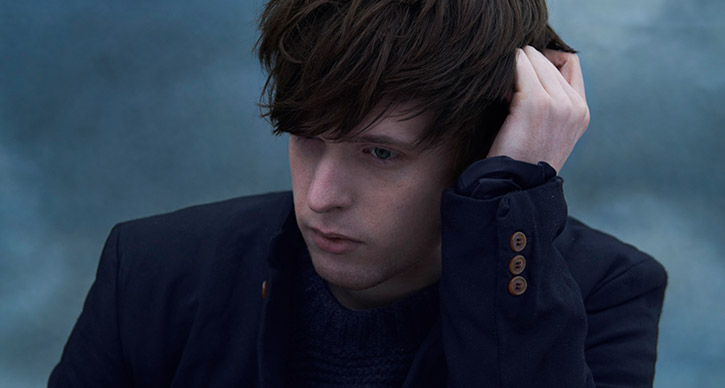
Photo: James Blake (performing in Ann Arbor on November 11, 2013).
Perhaps because, as a kid, I studied and practiced Western European classical music while primarily listening to 1960’s and ’70’s rock, blues, and jazz, I find myself with an affinity for a range of diverse styles, especially hybrid ones. I’m a firm believer that it’s not about the genre, but rather about the music itself. Here’s a bit of what I’ve been drawn to lately.
Listen on Spotify:
What did you think about this playlist? Share your thoughts or song suggestions in the comments below.



